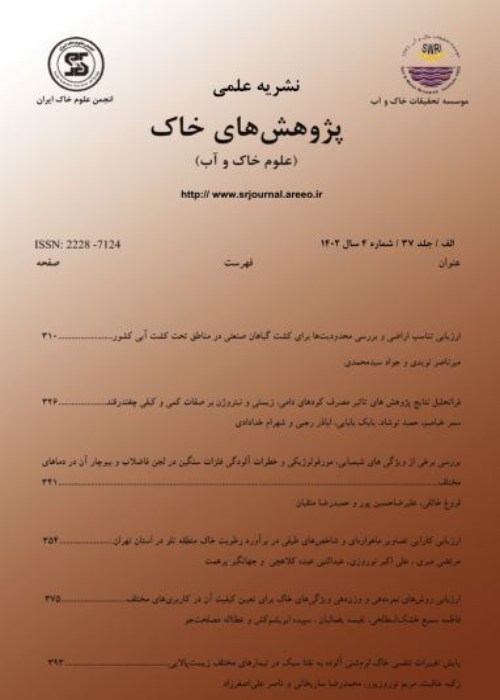Geostatic and GIS Evaluation of Spatial Variability of Nitrogen, Phosphorus, Potassium, and Cation Exchange Capacity in Agro-Industrial Land of Sharif Abad in Qazvin
Author(s):
Abstract:
Soil plays a crucial role in biogeochemical cycles as an important source and sink of nutrients. Soil properties, distribution, and changes are important factors in agriculture. In this study, 600 samples were collected at 100 x 100 m intervals from 0-30 cm depthin 800 hectares of agro-industrial land of Sharif Abad, in Qazvin. Analysis of classical statistics and geostatistical analysis were performed on the collected data. The results showed that changes in soil total nitrogen varied within a range of 0.02% to 0.82% with an average of 0.26%, while Olsen extractable phosphorus varied within a range of 9.58 to 93.07 mg/kg, with an average of 36.21 mg/kg. Changes in ammonium acetate extractable potassium varied within a range of 180 to 1740 mg/kg, with an average of 552.87 mg/kg. Also, cation exchange capacity varied within a range of 11.44 to 50.16 with an average of 28.20 meq/100 g soil. Exponential model was the best semivariogram model for all studied parameters. Effective ranges for N, P, K and cation exchange capacity were, respectively, 510 m, 798 m, 567 m and 1476 m. Kriging estimator was used to prepare zoning map of the studied traits. The results showed that the relative area of zones with less than 0.1% total nitrogen element was zero percent (0% of the total area), between 0.1-0.2% (3.5%); between 0.2-0.3% (74.3%), and for more than 0.3%, it was 22.2%. In addition, for elemental P, the extent of zones for less than 12 mg/kg was zero percent, between 12-24 mg/kg was 7.8%, between 24-36 mg/kg was 48.4%, and for values more than 36 mg/kg, the extent was 43.8%. In the case of elemental K, the extent of zones for less than 250 mg/kg was zero percent, from 250 to 400 mg/kg it was 4.6%, from 400 to 600 mg/kg the extent was 72%, and for values more than 600 mg/kg, it was 23.4%. Moreover, for cation exchange capacity less than 10 meq per 100 g soil, the extent of zones was zero percent, between 10 and 20 meq per 100 g soil, the extent was 13.1%, between 20 and 30 meq per 100 g soil, it was 44.6%, and for more than 30 meq per 100 g soil, the extent of zones was 42.3%.
Keywords:
Language:
Persian
Published:
Iranian Journal of Soil Research, Volume:31 Issue: 2, 2017
Pages:
195 to 213
magiran.com/p1734626
دانلود و مطالعه متن این مقاله با یکی از روشهای زیر امکان پذیر است:
اشتراک شخصی
با عضویت و پرداخت آنلاین حق اشتراک یکساله به مبلغ 1,390,000ريال میتوانید 70 عنوان مطلب دانلود کنید!
اشتراک سازمانی
به کتابخانه دانشگاه یا محل کار خود پیشنهاد کنید تا اشتراک سازمانی این پایگاه را برای دسترسی نامحدود همه کاربران به متن مطالب تهیه نمایند!
توجه!
- حق عضویت دریافتی صرف حمایت از نشریات عضو و نگهداری، تکمیل و توسعه مگیران میشود.
- پرداخت حق اشتراک و دانلود مقالات اجازه بازنشر آن در سایر رسانههای چاپی و دیجیتال را به کاربر نمیدهد.
In order to view content subscription is required
Personal subscription
Subscribe magiran.com for 70 € euros via PayPal and download 70 articles during a year.
Organization subscription
Please contact us to subscribe your university or library for unlimited access!


